Management and Leadership in Toyota: A Comparative Analysis Report
VerifiedAdded on 2020/10/22
|15
|5325
|482
Report
AI Summary
This report provides a comprehensive analysis of leadership and management within Toyota, a prominent multinational car manufacturer. It begins by comparing the distinct roles and characteristics of leaders and managers, emphasizing their differing responsibilities and approaches within the organization. The report then delves into the application of various leadership theories, such as situational leadership and transactional leadership, to differentiate between leadership and management functions. It further explores how leaders and managers handle situations like conflict, cost increases, and financial crises, highlighting the practical implications of their roles. The report also assesses the application of situational leadership, system leadership, and contingency leadership, providing insights into how these approaches affect Toyota's operations and employee performance. Finally, the report concludes by summarizing the relationship between leadership and management in a contemporary business environment, emphasizing the significance of effective leadership and management practices for achieving business objectives.
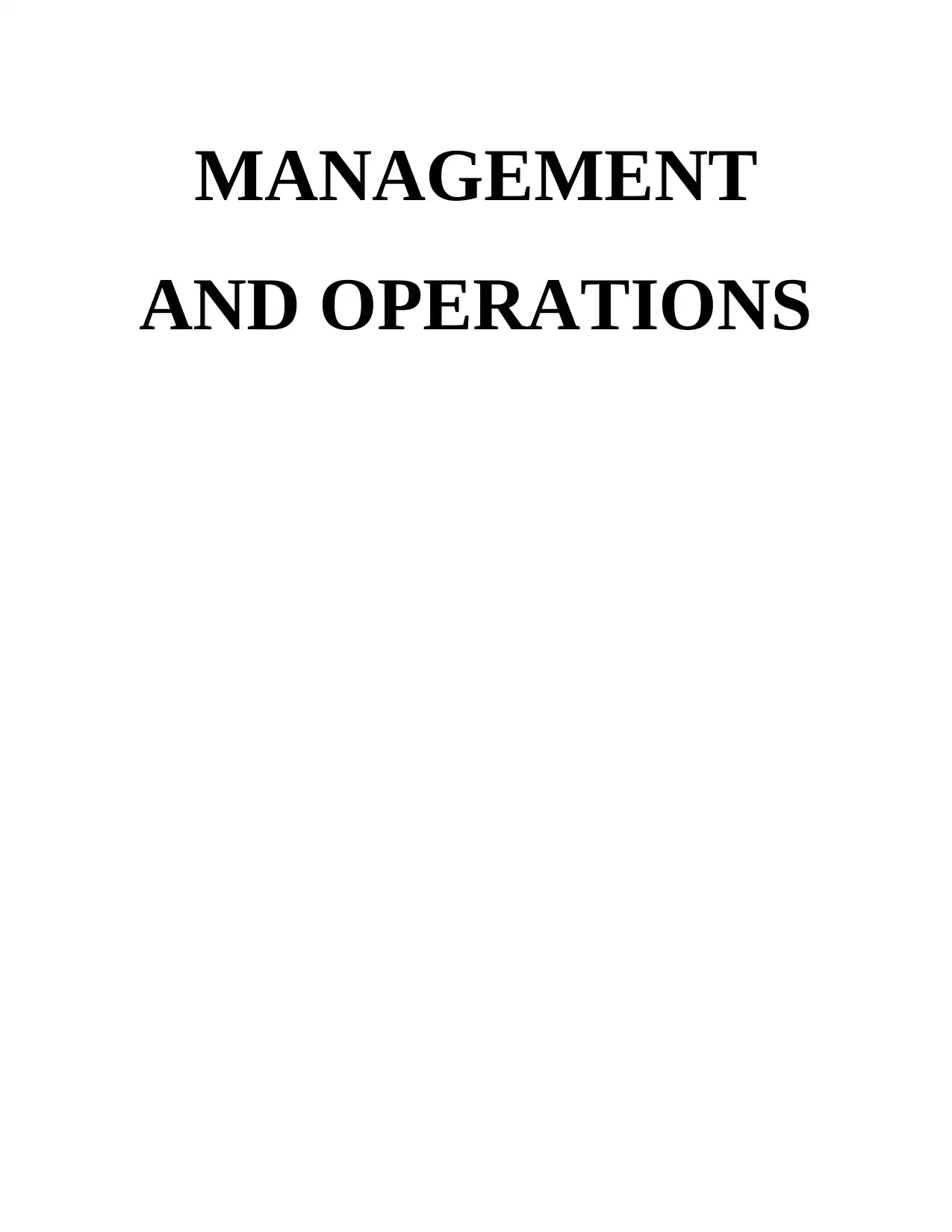
MANAGEMENT
AND OPERATIONS
AND OPERATIONS
Paraphrase This Document
Need a fresh take? Get an instant paraphrase of this document with our AI Paraphraser
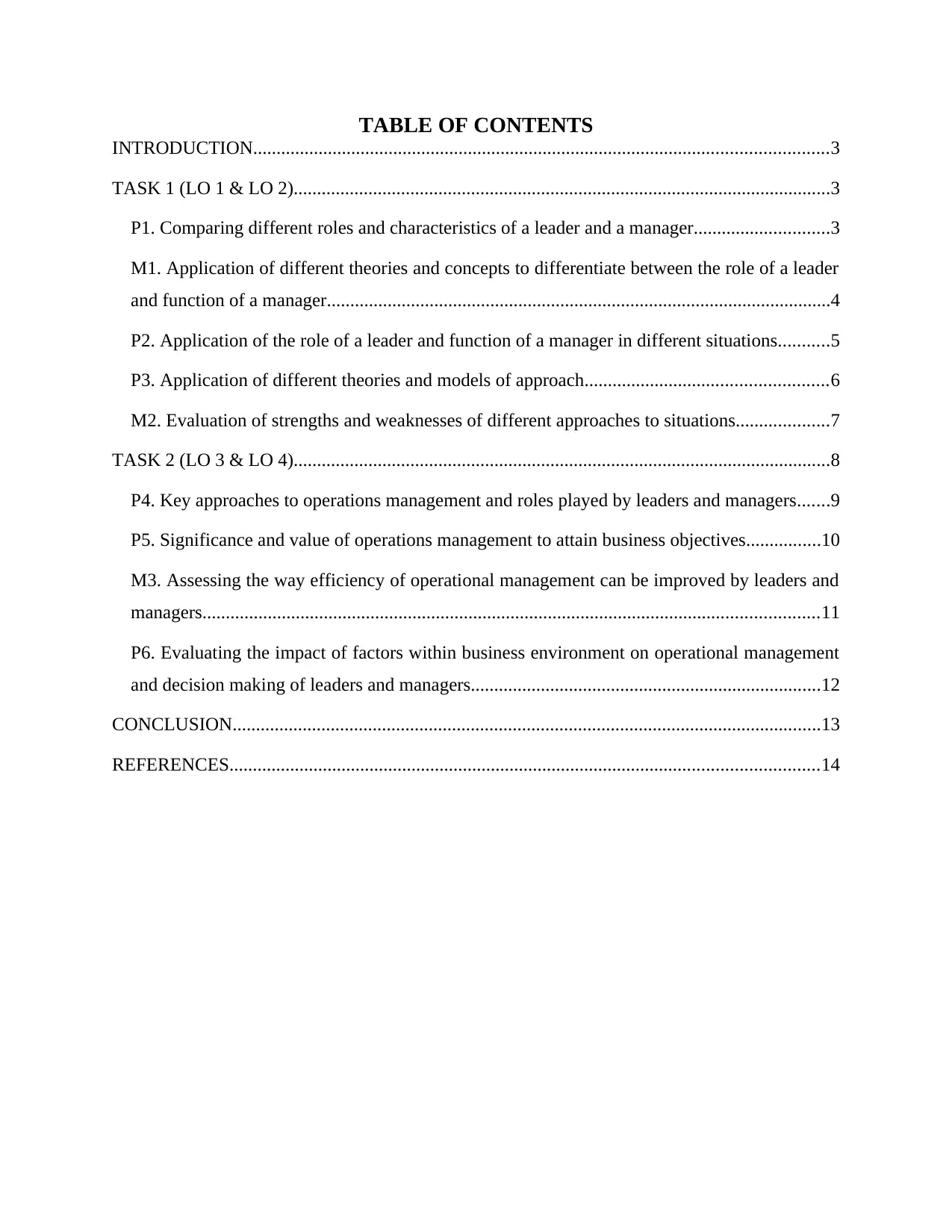
TABLE OF CONTENTS
INTRODUCTION...........................................................................................................................3
TASK 1 (LO 1 & LO 2)...................................................................................................................3
P1. Comparing different roles and characteristics of a leader and a manager.............................3
M1. Application of different theories and concepts to differentiate between the role of a leader
and function of a manager............................................................................................................4
P2. Application of the role of a leader and function of a manager in different situations...........5
P3. Application of different theories and models of approach....................................................6
M2. Evaluation of strengths and weaknesses of different approaches to situations....................7
TASK 2 (LO 3 & LO 4)...................................................................................................................8
P4. Key approaches to operations management and roles played by leaders and managers.......9
P5. Significance and value of operations management to attain business objectives................10
M3. Assessing the way efficiency of operational management can be improved by leaders and
managers....................................................................................................................................11
P6. Evaluating the impact of factors within business environment on operational management
and decision making of leaders and managers...........................................................................12
CONCLUSION..............................................................................................................................13
REFERENCES..............................................................................................................................14
INTRODUCTION...........................................................................................................................3
TASK 1 (LO 1 & LO 2)...................................................................................................................3
P1. Comparing different roles and characteristics of a leader and a manager.............................3
M1. Application of different theories and concepts to differentiate between the role of a leader
and function of a manager............................................................................................................4
P2. Application of the role of a leader and function of a manager in different situations...........5
P3. Application of different theories and models of approach....................................................6
M2. Evaluation of strengths and weaknesses of different approaches to situations....................7
TASK 2 (LO 3 & LO 4)...................................................................................................................8
P4. Key approaches to operations management and roles played by leaders and managers.......9
P5. Significance and value of operations management to attain business objectives................10
M3. Assessing the way efficiency of operational management can be improved by leaders and
managers....................................................................................................................................11
P6. Evaluating the impact of factors within business environment on operational management
and decision making of leaders and managers...........................................................................12
CONCLUSION..............................................................................................................................13
REFERENCES..............................................................................................................................14
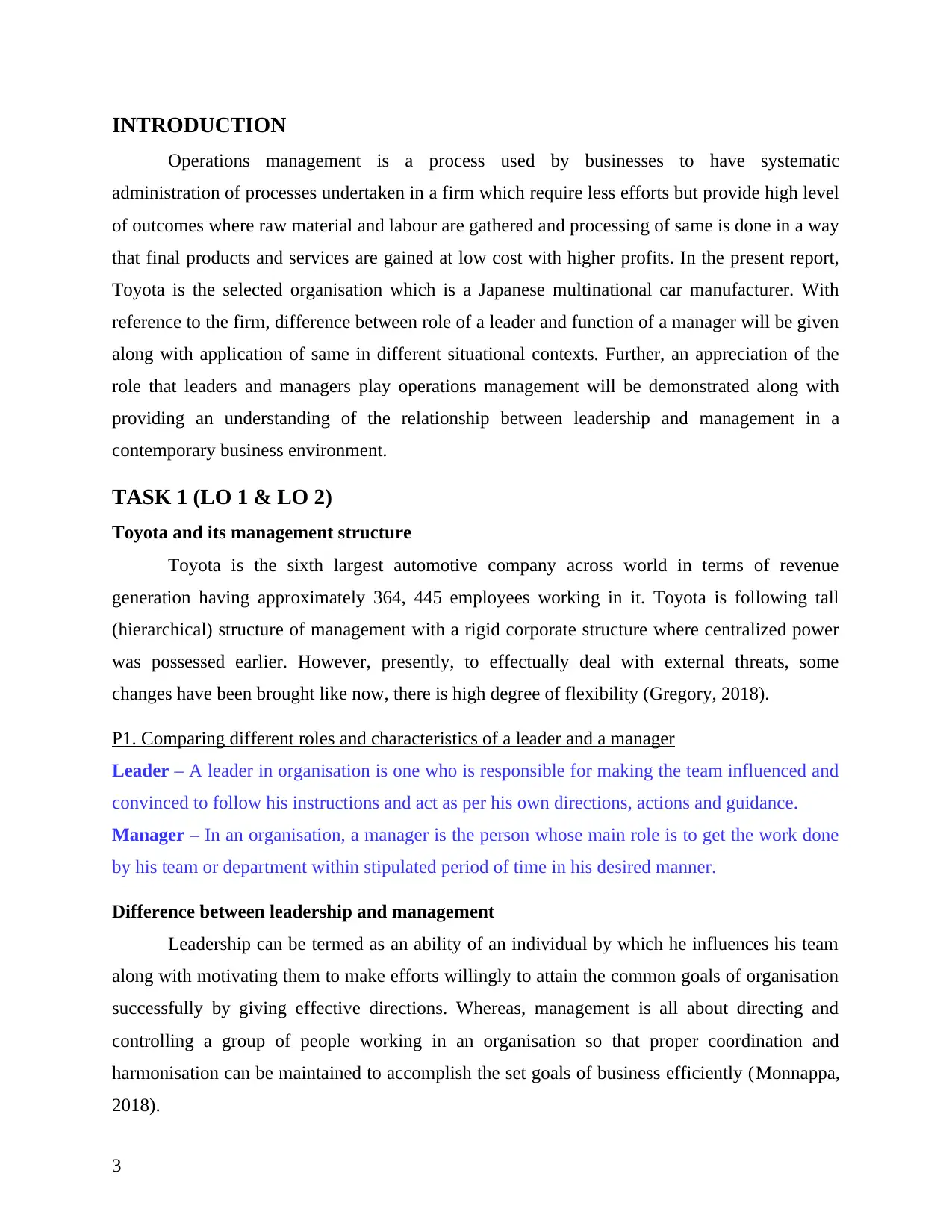
INTRODUCTION
Operations management is a process used by businesses to have systematic
administration of processes undertaken in a firm which require less efforts but provide high level
of outcomes where raw material and labour are gathered and processing of same is done in a way
that final products and services are gained at low cost with higher profits. In the present report,
Toyota is the selected organisation which is a Japanese multinational car manufacturer. With
reference to the firm, difference between role of a leader and function of a manager will be given
along with application of same in different situational contexts. Further, an appreciation of the
role that leaders and managers play operations management will be demonstrated along with
providing an understanding of the relationship between leadership and management in a
contemporary business environment.
TASK 1 (LO 1 & LO 2)
Toyota and its management structure
Toyota is the sixth largest automotive company across world in terms of revenue
generation having approximately 364, 445 employees working in it. Toyota is following tall
(hierarchical) structure of management with a rigid corporate structure where centralized power
was possessed earlier. However, presently, to effectually deal with external threats, some
changes have been brought like now, there is high degree of flexibility (Gregory, 2018).
P1. Comparing different roles and characteristics of a leader and a manager
Leader – A leader in organisation is one who is responsible for making the team influenced and
convinced to follow his instructions and act as per his own directions, actions and guidance.
Manager – In an organisation, a manager is the person whose main role is to get the work done
by his team or department within stipulated period of time in his desired manner.
Difference between leadership and management
Leadership can be termed as an ability of an individual by which he influences his team
along with motivating them to make efforts willingly to attain the common goals of organisation
successfully by giving effective directions. Whereas, management is all about directing and
controlling a group of people working in an organisation so that proper coordination and
harmonisation can be maintained to accomplish the set goals of business efficiently (Monnappa,
2018).
3
Operations management is a process used by businesses to have systematic
administration of processes undertaken in a firm which require less efforts but provide high level
of outcomes where raw material and labour are gathered and processing of same is done in a way
that final products and services are gained at low cost with higher profits. In the present report,
Toyota is the selected organisation which is a Japanese multinational car manufacturer. With
reference to the firm, difference between role of a leader and function of a manager will be given
along with application of same in different situational contexts. Further, an appreciation of the
role that leaders and managers play operations management will be demonstrated along with
providing an understanding of the relationship between leadership and management in a
contemporary business environment.
TASK 1 (LO 1 & LO 2)
Toyota and its management structure
Toyota is the sixth largest automotive company across world in terms of revenue
generation having approximately 364, 445 employees working in it. Toyota is following tall
(hierarchical) structure of management with a rigid corporate structure where centralized power
was possessed earlier. However, presently, to effectually deal with external threats, some
changes have been brought like now, there is high degree of flexibility (Gregory, 2018).
P1. Comparing different roles and characteristics of a leader and a manager
Leader – A leader in organisation is one who is responsible for making the team influenced and
convinced to follow his instructions and act as per his own directions, actions and guidance.
Manager – In an organisation, a manager is the person whose main role is to get the work done
by his team or department within stipulated period of time in his desired manner.
Difference between leadership and management
Leadership can be termed as an ability of an individual by which he influences his team
along with motivating them to make efforts willingly to attain the common goals of organisation
successfully by giving effective directions. Whereas, management is all about directing and
controlling a group of people working in an organisation so that proper coordination and
harmonisation can be maintained to accomplish the set goals of business efficiently (Monnappa,
2018).
3
⊘ This is a preview!⊘
Do you want full access?
Subscribe today to unlock all pages.

Trusted by 1+ million students worldwide
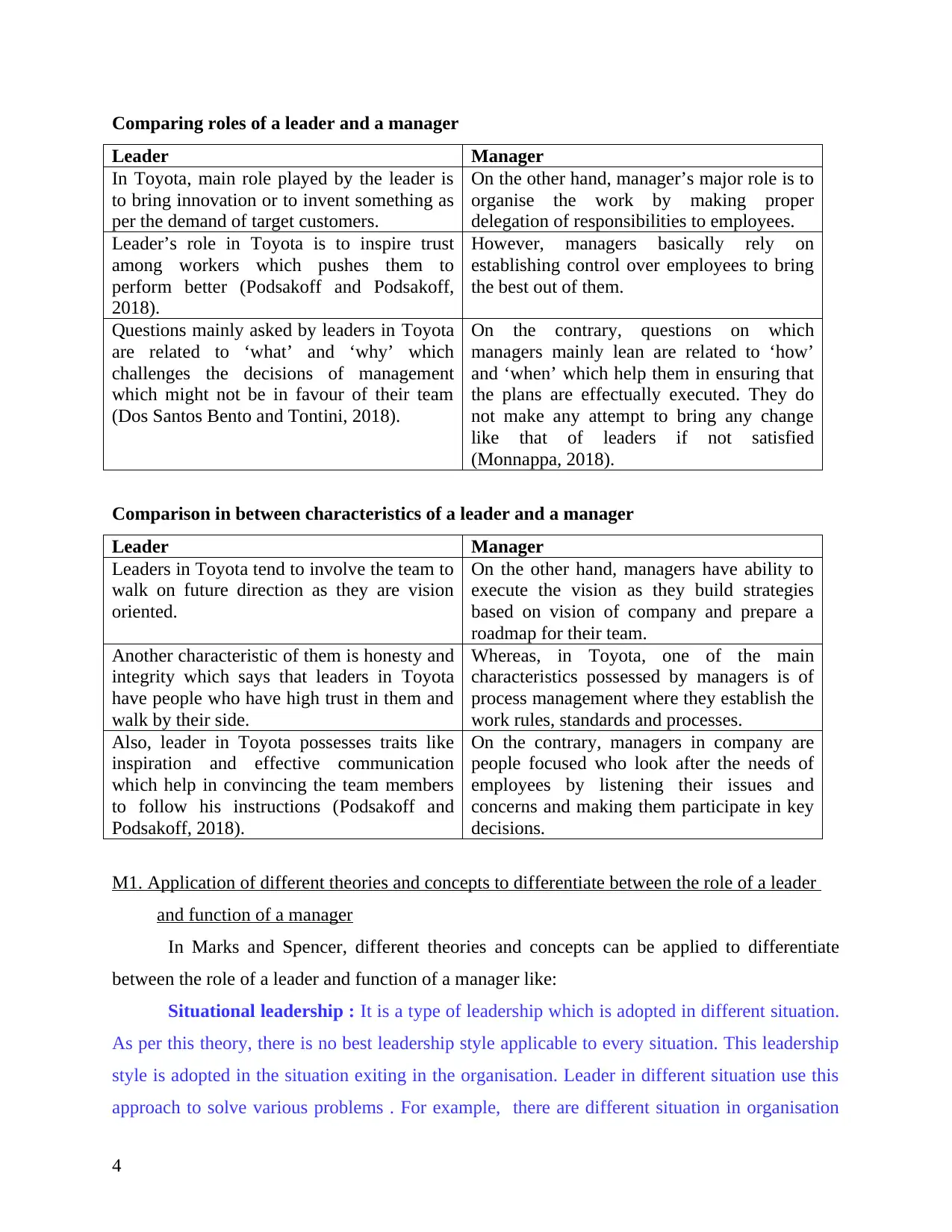
Comparing roles of a leader and a manager
Leader Manager
In Toyota, main role played by the leader is
to bring innovation or to invent something as
per the demand of target customers.
On the other hand, manager’s major role is to
organise the work by making proper
delegation of responsibilities to employees.
Leader’s role in Toyota is to inspire trust
among workers which pushes them to
perform better (Podsakoff and Podsakoff,
2018).
However, managers basically rely on
establishing control over employees to bring
the best out of them.
Questions mainly asked by leaders in Toyota
are related to ‘what’ and ‘why’ which
challenges the decisions of management
which might not be in favour of their team
(Dos Santos Bento and Tontini, 2018).
On the contrary, questions on which
managers mainly lean are related to ‘how’
and ‘when’ which help them in ensuring that
the plans are effectually executed. They do
not make any attempt to bring any change
like that of leaders if not satisfied
(Monnappa, 2018).
Comparison in between characteristics of a leader and a manager
Leader Manager
Leaders in Toyota tend to involve the team to
walk on future direction as they are vision
oriented.
On the other hand, managers have ability to
execute the vision as they build strategies
based on vision of company and prepare a
roadmap for their team.
Another characteristic of them is honesty and
integrity which says that leaders in Toyota
have people who have high trust in them and
walk by their side.
Whereas, in Toyota, one of the main
characteristics possessed by managers is of
process management where they establish the
work rules, standards and processes.
Also, leader in Toyota possesses traits like
inspiration and effective communication
which help in convincing the team members
to follow his instructions (Podsakoff and
Podsakoff, 2018).
On the contrary, managers in company are
people focused who look after the needs of
employees by listening their issues and
concerns and making them participate in key
decisions.
M1. Application of different theories and concepts to differentiate between the role of a leader
and function of a manager
In Marks and Spencer, different theories and concepts can be applied to differentiate
between the role of a leader and function of a manager like:
Situational leadership : It is a type of leadership which is adopted in different situation.
As per this theory, there is no best leadership style applicable to every situation. This leadership
style is adopted in the situation exiting in the organisation. Leader in different situation use this
approach to solve various problems . For example, there are different situation in organisation
4
Leader Manager
In Toyota, main role played by the leader is
to bring innovation or to invent something as
per the demand of target customers.
On the other hand, manager’s major role is to
organise the work by making proper
delegation of responsibilities to employees.
Leader’s role in Toyota is to inspire trust
among workers which pushes them to
perform better (Podsakoff and Podsakoff,
2018).
However, managers basically rely on
establishing control over employees to bring
the best out of them.
Questions mainly asked by leaders in Toyota
are related to ‘what’ and ‘why’ which
challenges the decisions of management
which might not be in favour of their team
(Dos Santos Bento and Tontini, 2018).
On the contrary, questions on which
managers mainly lean are related to ‘how’
and ‘when’ which help them in ensuring that
the plans are effectually executed. They do
not make any attempt to bring any change
like that of leaders if not satisfied
(Monnappa, 2018).
Comparison in between characteristics of a leader and a manager
Leader Manager
Leaders in Toyota tend to involve the team to
walk on future direction as they are vision
oriented.
On the other hand, managers have ability to
execute the vision as they build strategies
based on vision of company and prepare a
roadmap for their team.
Another characteristic of them is honesty and
integrity which says that leaders in Toyota
have people who have high trust in them and
walk by their side.
Whereas, in Toyota, one of the main
characteristics possessed by managers is of
process management where they establish the
work rules, standards and processes.
Also, leader in Toyota possesses traits like
inspiration and effective communication
which help in convincing the team members
to follow his instructions (Podsakoff and
Podsakoff, 2018).
On the contrary, managers in company are
people focused who look after the needs of
employees by listening their issues and
concerns and making them participate in key
decisions.
M1. Application of different theories and concepts to differentiate between the role of a leader
and function of a manager
In Marks and Spencer, different theories and concepts can be applied to differentiate
between the role of a leader and function of a manager like:
Situational leadership : It is a type of leadership which is adopted in different situation.
As per this theory, there is no best leadership style applicable to every situation. This leadership
style is adopted in the situation exiting in the organisation. Leader in different situation use this
approach to solve various problems . For example, there are different situation in organisation
4
Paraphrase This Document
Need a fresh take? Get an instant paraphrase of this document with our AI Paraphraser
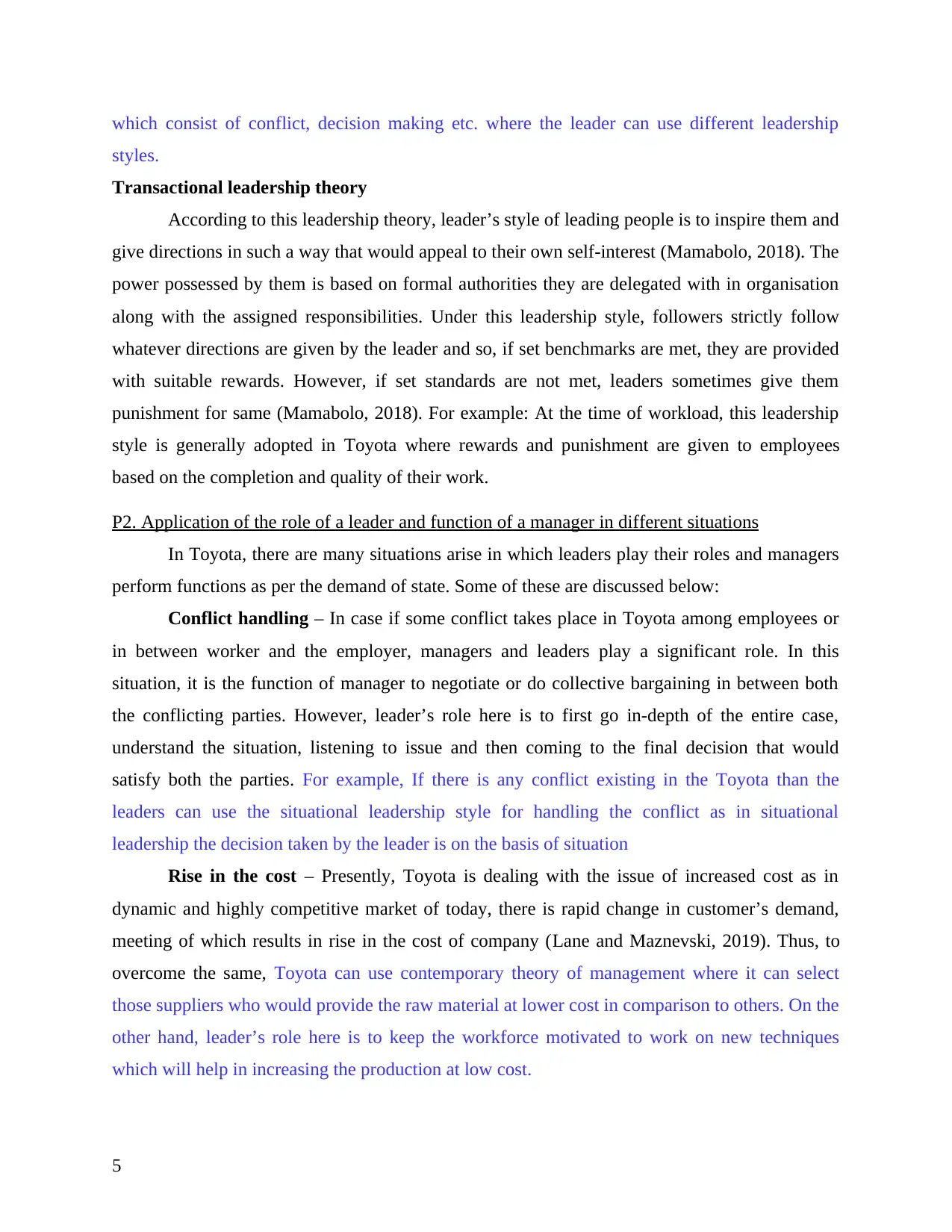
which consist of conflict, decision making etc. where the leader can use different leadership
styles.
Transactional leadership theory
According to this leadership theory, leader’s style of leading people is to inspire them and
give directions in such a way that would appeal to their own self-interest (Mamabolo, 2018). The
power possessed by them is based on formal authorities they are delegated with in organisation
along with the assigned responsibilities. Under this leadership style, followers strictly follow
whatever directions are given by the leader and so, if set benchmarks are met, they are provided
with suitable rewards. However, if set standards are not met, leaders sometimes give them
punishment for same (Mamabolo, 2018). For example: At the time of workload, this leadership
style is generally adopted in Toyota where rewards and punishment are given to employees
based on the completion and quality of their work.
P2. Application of the role of a leader and function of a manager in different situations
In Toyota, there are many situations arise in which leaders play their roles and managers
perform functions as per the demand of state. Some of these are discussed below:
Conflict handling – In case if some conflict takes place in Toyota among employees or
in between worker and the employer, managers and leaders play a significant role. In this
situation, it is the function of manager to negotiate or do collective bargaining in between both
the conflicting parties. However, leader’s role here is to first go in-depth of the entire case,
understand the situation, listening to issue and then coming to the final decision that would
satisfy both the parties. For example, If there is any conflict existing in the Toyota than the
leaders can use the situational leadership style for handling the conflict as in situational
leadership the decision taken by the leader is on the basis of situation
Rise in the cost – Presently, Toyota is dealing with the issue of increased cost as in
dynamic and highly competitive market of today, there is rapid change in customer’s demand,
meeting of which results in rise in the cost of company (Lane and Maznevski, 2019). Thus, to
overcome the same, Toyota can use contemporary theory of management where it can select
those suppliers who would provide the raw material at lower cost in comparison to others. On the
other hand, leader’s role here is to keep the workforce motivated to work on new techniques
which will help in increasing the production at low cost.
5
styles.
Transactional leadership theory
According to this leadership theory, leader’s style of leading people is to inspire them and
give directions in such a way that would appeal to their own self-interest (Mamabolo, 2018). The
power possessed by them is based on formal authorities they are delegated with in organisation
along with the assigned responsibilities. Under this leadership style, followers strictly follow
whatever directions are given by the leader and so, if set benchmarks are met, they are provided
with suitable rewards. However, if set standards are not met, leaders sometimes give them
punishment for same (Mamabolo, 2018). For example: At the time of workload, this leadership
style is generally adopted in Toyota where rewards and punishment are given to employees
based on the completion and quality of their work.
P2. Application of the role of a leader and function of a manager in different situations
In Toyota, there are many situations arise in which leaders play their roles and managers
perform functions as per the demand of state. Some of these are discussed below:
Conflict handling – In case if some conflict takes place in Toyota among employees or
in between worker and the employer, managers and leaders play a significant role. In this
situation, it is the function of manager to negotiate or do collective bargaining in between both
the conflicting parties. However, leader’s role here is to first go in-depth of the entire case,
understand the situation, listening to issue and then coming to the final decision that would
satisfy both the parties. For example, If there is any conflict existing in the Toyota than the
leaders can use the situational leadership style for handling the conflict as in situational
leadership the decision taken by the leader is on the basis of situation
Rise in the cost – Presently, Toyota is dealing with the issue of increased cost as in
dynamic and highly competitive market of today, there is rapid change in customer’s demand,
meeting of which results in rise in the cost of company (Lane and Maznevski, 2019). Thus, to
overcome the same, Toyota can use contemporary theory of management where it can select
those suppliers who would provide the raw material at lower cost in comparison to others. On the
other hand, leader’s role here is to keep the workforce motivated to work on new techniques
which will help in increasing the production at low cost.
5
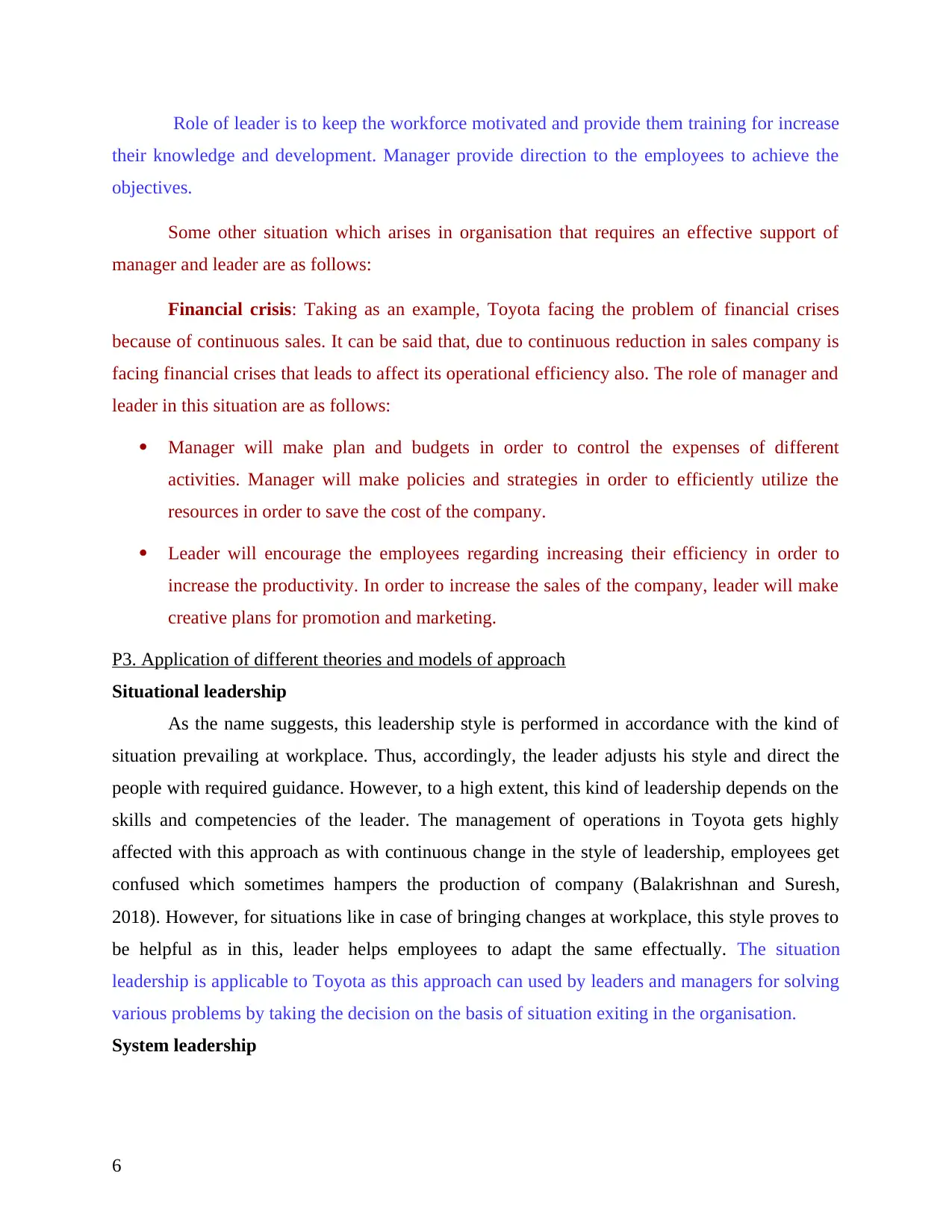
Role of leader is to keep the workforce motivated and provide them training for increase
their knowledge and development. Manager provide direction to the employees to achieve the
objectives.
Some other situation which arises in organisation that requires an effective support of
manager and leader are as follows:
Financial crisis: Taking as an example, Toyota facing the problem of financial crises
because of continuous sales. It can be said that, due to continuous reduction in sales company is
facing financial crises that leads to affect its operational efficiency also. The role of manager and
leader in this situation are as follows:
Manager will make plan and budgets in order to control the expenses of different
activities. Manager will make policies and strategies in order to efficiently utilize the
resources in order to save the cost of the company.
Leader will encourage the employees regarding increasing their efficiency in order to
increase the productivity. In order to increase the sales of the company, leader will make
creative plans for promotion and marketing.
P3. Application of different theories and models of approach
Situational leadership
As the name suggests, this leadership style is performed in accordance with the kind of
situation prevailing at workplace. Thus, accordingly, the leader adjusts his style and direct the
people with required guidance. However, to a high extent, this kind of leadership depends on the
skills and competencies of the leader. The management of operations in Toyota gets highly
affected with this approach as with continuous change in the style of leadership, employees get
confused which sometimes hampers the production of company (Balakrishnan and Suresh,
2018). However, for situations like in case of bringing changes at workplace, this style proves to
be helpful as in this, leader helps employees to adapt the same effectually. The situation
leadership is applicable to Toyota as this approach can used by leaders and managers for solving
various problems by taking the decision on the basis of situation exiting in the organisation.
System leadership
6
their knowledge and development. Manager provide direction to the employees to achieve the
objectives.
Some other situation which arises in organisation that requires an effective support of
manager and leader are as follows:
Financial crisis: Taking as an example, Toyota facing the problem of financial crises
because of continuous sales. It can be said that, due to continuous reduction in sales company is
facing financial crises that leads to affect its operational efficiency also. The role of manager and
leader in this situation are as follows:
Manager will make plan and budgets in order to control the expenses of different
activities. Manager will make policies and strategies in order to efficiently utilize the
resources in order to save the cost of the company.
Leader will encourage the employees regarding increasing their efficiency in order to
increase the productivity. In order to increase the sales of the company, leader will make
creative plans for promotion and marketing.
P3. Application of different theories and models of approach
Situational leadership
As the name suggests, this leadership style is performed in accordance with the kind of
situation prevailing at workplace. Thus, accordingly, the leader adjusts his style and direct the
people with required guidance. However, to a high extent, this kind of leadership depends on the
skills and competencies of the leader. The management of operations in Toyota gets highly
affected with this approach as with continuous change in the style of leadership, employees get
confused which sometimes hampers the production of company (Balakrishnan and Suresh,
2018). However, for situations like in case of bringing changes at workplace, this style proves to
be helpful as in this, leader helps employees to adapt the same effectually. The situation
leadership is applicable to Toyota as this approach can used by leaders and managers for solving
various problems by taking the decision on the basis of situation exiting in the organisation.
System leadership
6
⊘ This is a preview!⊘
Do you want full access?
Subscribe today to unlock all pages.

Trusted by 1+ million students worldwide
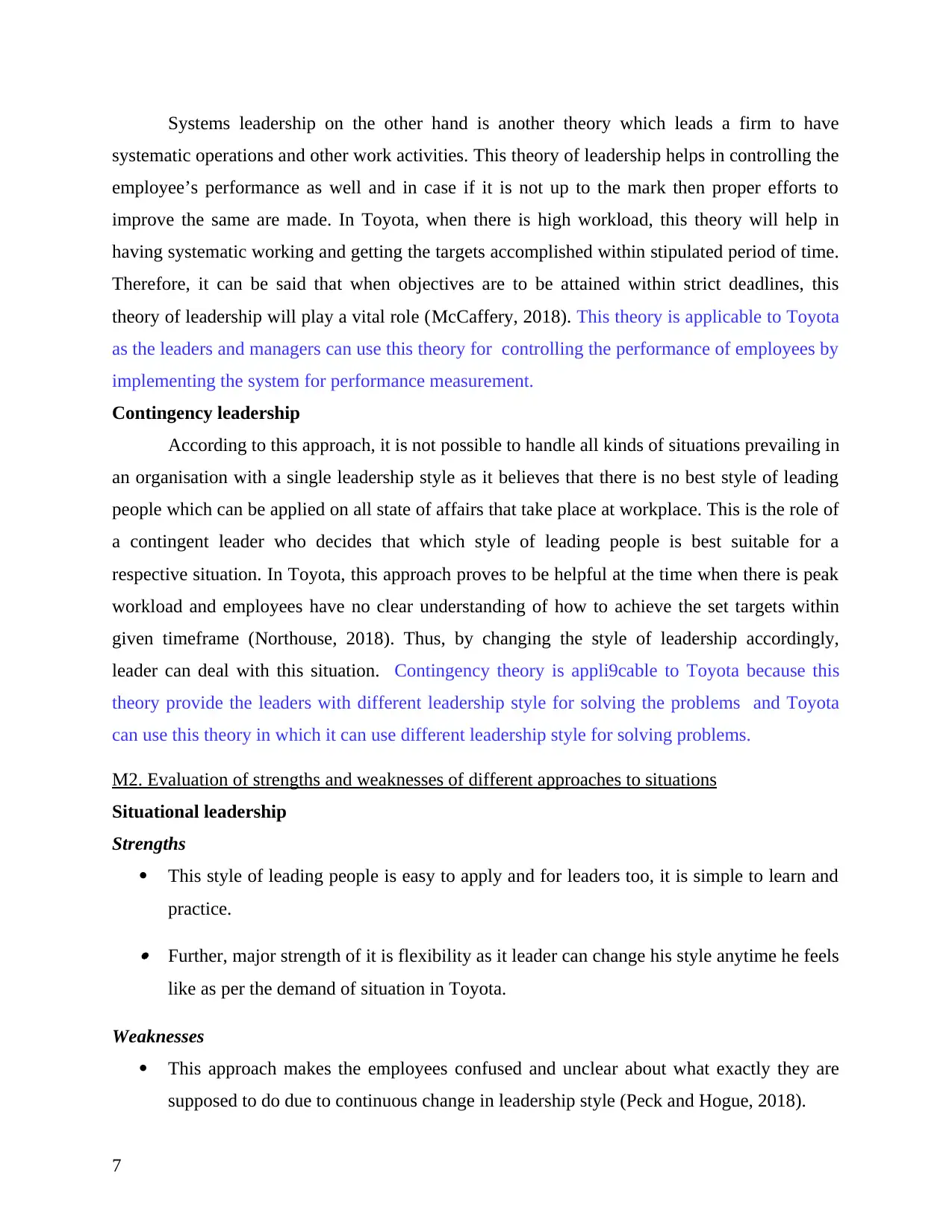
Systems leadership on the other hand is another theory which leads a firm to have
systematic operations and other work activities. This theory of leadership helps in controlling the
employee’s performance as well and in case if it is not up to the mark then proper efforts to
improve the same are made. In Toyota, when there is high workload, this theory will help in
having systematic working and getting the targets accomplished within stipulated period of time.
Therefore, it can be said that when objectives are to be attained within strict deadlines, this
theory of leadership will play a vital role (McCaffery, 2018). This theory is applicable to Toyota
as the leaders and managers can use this theory for controlling the performance of employees by
implementing the system for performance measurement.
Contingency leadership
According to this approach, it is not possible to handle all kinds of situations prevailing in
an organisation with a single leadership style as it believes that there is no best style of leading
people which can be applied on all state of affairs that take place at workplace. This is the role of
a contingent leader who decides that which style of leading people is best suitable for a
respective situation. In Toyota, this approach proves to be helpful at the time when there is peak
workload and employees have no clear understanding of how to achieve the set targets within
given timeframe (Northouse, 2018). Thus, by changing the style of leadership accordingly,
leader can deal with this situation. Contingency theory is appli9cable to Toyota because this
theory provide the leaders with different leadership style for solving the problems and Toyota
can use this theory in which it can use different leadership style for solving problems.
M2. Evaluation of strengths and weaknesses of different approaches to situations
Situational leadership
Strengths
This style of leading people is easy to apply and for leaders too, it is simple to learn and
practice.
Further, major strength of it is flexibility as it leader can change his style anytime he feels
like as per the demand of situation in Toyota.
Weaknesses
This approach makes the employees confused and unclear about what exactly they are
supposed to do due to continuous change in leadership style (Peck and Hogue, 2018).
7
systematic operations and other work activities. This theory of leadership helps in controlling the
employee’s performance as well and in case if it is not up to the mark then proper efforts to
improve the same are made. In Toyota, when there is high workload, this theory will help in
having systematic working and getting the targets accomplished within stipulated period of time.
Therefore, it can be said that when objectives are to be attained within strict deadlines, this
theory of leadership will play a vital role (McCaffery, 2018). This theory is applicable to Toyota
as the leaders and managers can use this theory for controlling the performance of employees by
implementing the system for performance measurement.
Contingency leadership
According to this approach, it is not possible to handle all kinds of situations prevailing in
an organisation with a single leadership style as it believes that there is no best style of leading
people which can be applied on all state of affairs that take place at workplace. This is the role of
a contingent leader who decides that which style of leading people is best suitable for a
respective situation. In Toyota, this approach proves to be helpful at the time when there is peak
workload and employees have no clear understanding of how to achieve the set targets within
given timeframe (Northouse, 2018). Thus, by changing the style of leadership accordingly,
leader can deal with this situation. Contingency theory is appli9cable to Toyota because this
theory provide the leaders with different leadership style for solving the problems and Toyota
can use this theory in which it can use different leadership style for solving problems.
M2. Evaluation of strengths and weaknesses of different approaches to situations
Situational leadership
Strengths
This style of leading people is easy to apply and for leaders too, it is simple to learn and
practice.
Further, major strength of it is flexibility as it leader can change his style anytime he feels
like as per the demand of situation in Toyota.
Weaknesses
This approach makes the employees confused and unclear about what exactly they are
supposed to do due to continuous change in leadership style (Peck and Hogue, 2018).
7
Paraphrase This Document
Need a fresh take? Get an instant paraphrase of this document with our AI Paraphraser
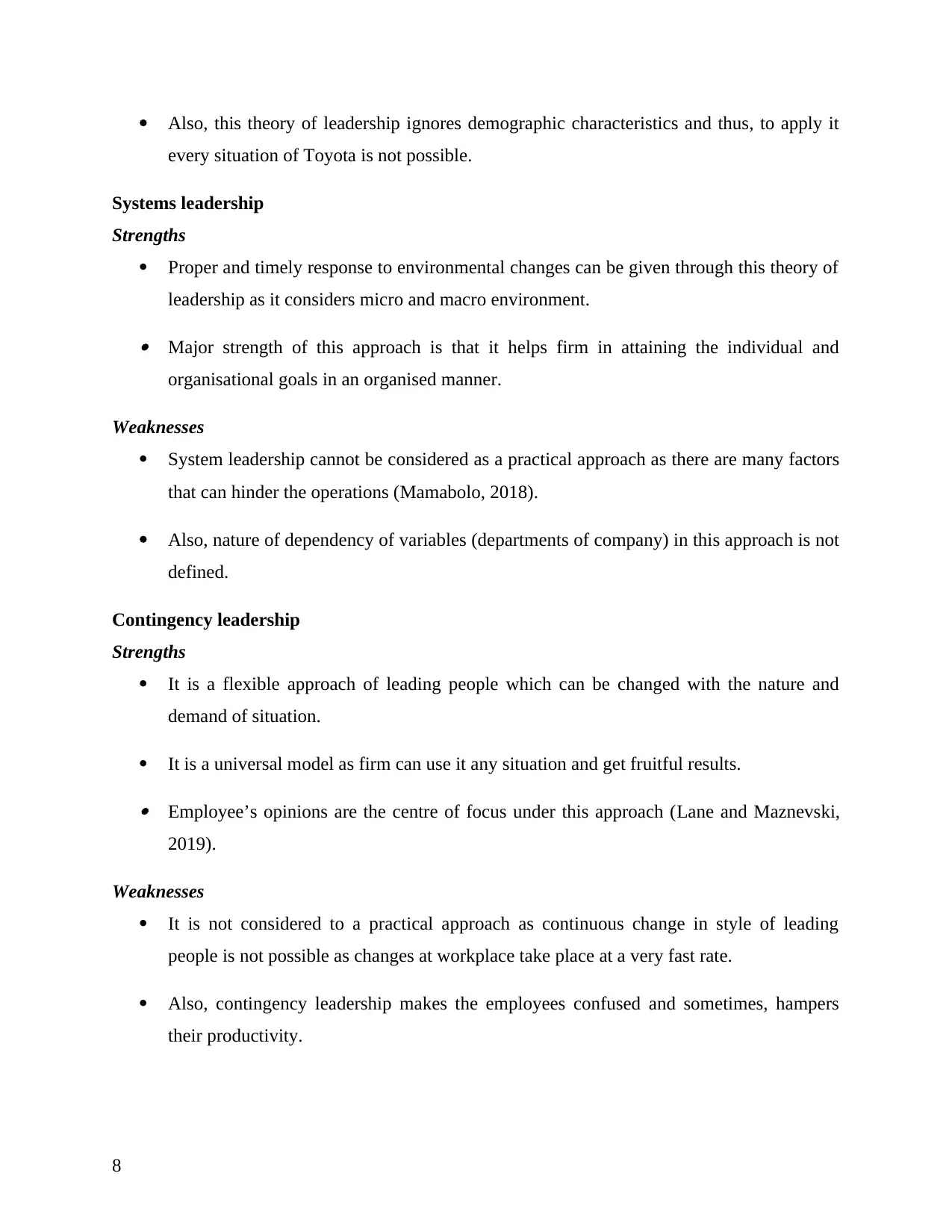
Also, this theory of leadership ignores demographic characteristics and thus, to apply it
every situation of Toyota is not possible.
Systems leadership
Strengths
Proper and timely response to environmental changes can be given through this theory of
leadership as it considers micro and macro environment.
Major strength of this approach is that it helps firm in attaining the individual and
organisational goals in an organised manner.
Weaknesses
System leadership cannot be considered as a practical approach as there are many factors
that can hinder the operations (Mamabolo, 2018).
Also, nature of dependency of variables (departments of company) in this approach is not
defined.
Contingency leadership
Strengths
It is a flexible approach of leading people which can be changed with the nature and
demand of situation.
It is a universal model as firm can use it any situation and get fruitful results.
Employee’s opinions are the centre of focus under this approach (Lane and Maznevski,
2019).
Weaknesses
It is not considered to a practical approach as continuous change in style of leading
people is not possible as changes at workplace take place at a very fast rate.
Also, contingency leadership makes the employees confused and sometimes, hampers
their productivity.
8
every situation of Toyota is not possible.
Systems leadership
Strengths
Proper and timely response to environmental changes can be given through this theory of
leadership as it considers micro and macro environment.
Major strength of this approach is that it helps firm in attaining the individual and
organisational goals in an organised manner.
Weaknesses
System leadership cannot be considered as a practical approach as there are many factors
that can hinder the operations (Mamabolo, 2018).
Also, nature of dependency of variables (departments of company) in this approach is not
defined.
Contingency leadership
Strengths
It is a flexible approach of leading people which can be changed with the nature and
demand of situation.
It is a universal model as firm can use it any situation and get fruitful results.
Employee’s opinions are the centre of focus under this approach (Lane and Maznevski,
2019).
Weaknesses
It is not considered to a practical approach as continuous change in style of leading
people is not possible as changes at workplace take place at a very fast rate.
Also, contingency leadership makes the employees confused and sometimes, hampers
their productivity.
8
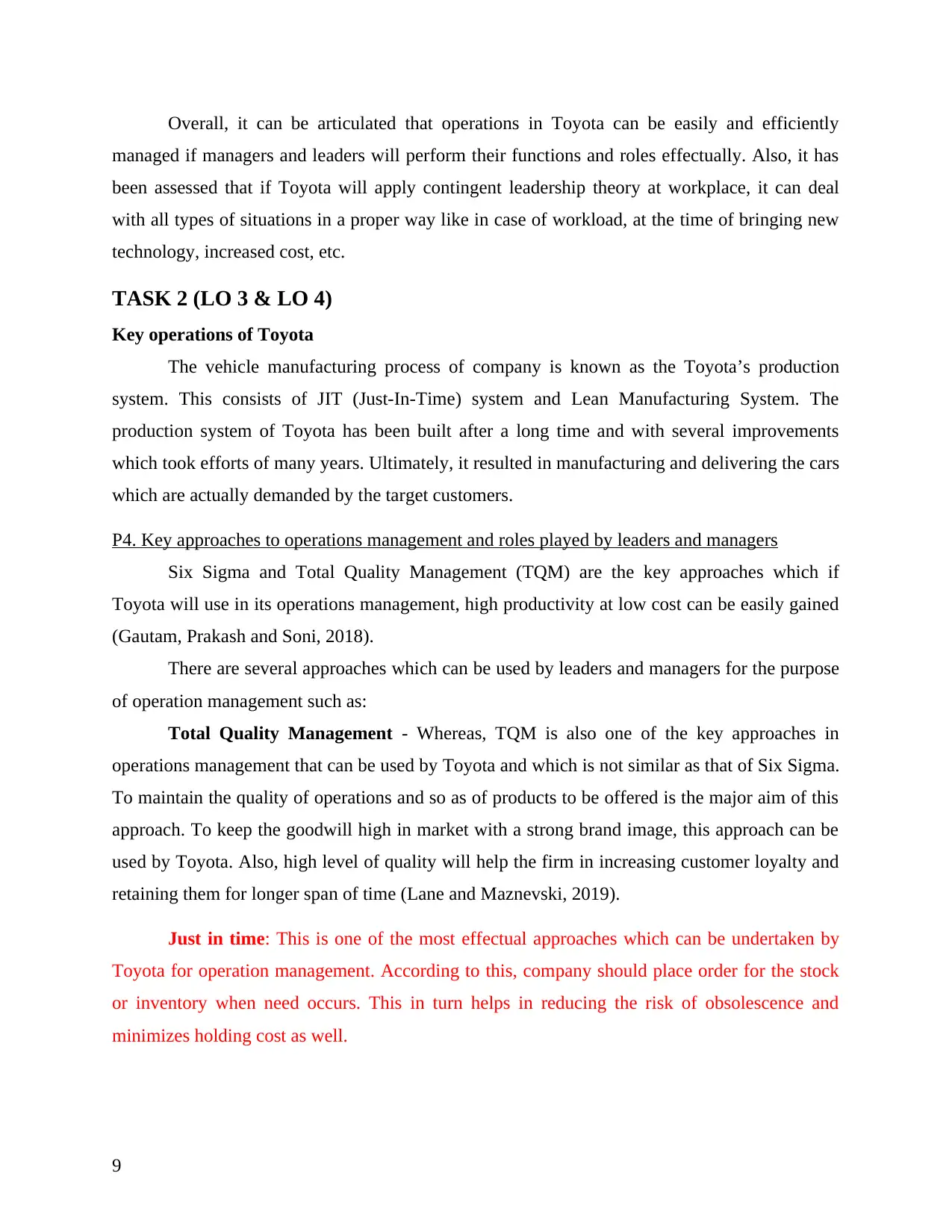
Overall, it can be articulated that operations in Toyota can be easily and efficiently
managed if managers and leaders will perform their functions and roles effectually. Also, it has
been assessed that if Toyota will apply contingent leadership theory at workplace, it can deal
with all types of situations in a proper way like in case of workload, at the time of bringing new
technology, increased cost, etc.
TASK 2 (LO 3 & LO 4)
Key operations of Toyota
The vehicle manufacturing process of company is known as the Toyota’s production
system. This consists of JIT (Just-In-Time) system and Lean Manufacturing System. The
production system of Toyota has been built after a long time and with several improvements
which took efforts of many years. Ultimately, it resulted in manufacturing and delivering the cars
which are actually demanded by the target customers.
P4. Key approaches to operations management and roles played by leaders and managers
Six Sigma and Total Quality Management (TQM) are the key approaches which if
Toyota will use in its operations management, high productivity at low cost can be easily gained
(Gautam, Prakash and Soni, 2018).
There are several approaches which can be used by leaders and managers for the purpose
of operation management such as:
Total Quality Management - Whereas, TQM is also one of the key approaches in
operations management that can be used by Toyota and which is not similar as that of Six Sigma.
To maintain the quality of operations and so as of products to be offered is the major aim of this
approach. To keep the goodwill high in market with a strong brand image, this approach can be
used by Toyota. Also, high level of quality will help the firm in increasing customer loyalty and
retaining them for longer span of time (Lane and Maznevski, 2019).
Just in time: This is one of the most effectual approaches which can be undertaken by
Toyota for operation management. According to this, company should place order for the stock
or inventory when need occurs. This in turn helps in reducing the risk of obsolescence and
minimizes holding cost as well.
9
managed if managers and leaders will perform their functions and roles effectually. Also, it has
been assessed that if Toyota will apply contingent leadership theory at workplace, it can deal
with all types of situations in a proper way like in case of workload, at the time of bringing new
technology, increased cost, etc.
TASK 2 (LO 3 & LO 4)
Key operations of Toyota
The vehicle manufacturing process of company is known as the Toyota’s production
system. This consists of JIT (Just-In-Time) system and Lean Manufacturing System. The
production system of Toyota has been built after a long time and with several improvements
which took efforts of many years. Ultimately, it resulted in manufacturing and delivering the cars
which are actually demanded by the target customers.
P4. Key approaches to operations management and roles played by leaders and managers
Six Sigma and Total Quality Management (TQM) are the key approaches which if
Toyota will use in its operations management, high productivity at low cost can be easily gained
(Gautam, Prakash and Soni, 2018).
There are several approaches which can be used by leaders and managers for the purpose
of operation management such as:
Total Quality Management - Whereas, TQM is also one of the key approaches in
operations management that can be used by Toyota and which is not similar as that of Six Sigma.
To maintain the quality of operations and so as of products to be offered is the major aim of this
approach. To keep the goodwill high in market with a strong brand image, this approach can be
used by Toyota. Also, high level of quality will help the firm in increasing customer loyalty and
retaining them for longer span of time (Lane and Maznevski, 2019).
Just in time: This is one of the most effectual approaches which can be undertaken by
Toyota for operation management. According to this, company should place order for the stock
or inventory when need occurs. This in turn helps in reducing the risk of obsolescence and
minimizes holding cost as well.
9
⊘ This is a preview!⊘
Do you want full access?
Subscribe today to unlock all pages.

Trusted by 1+ million students worldwide
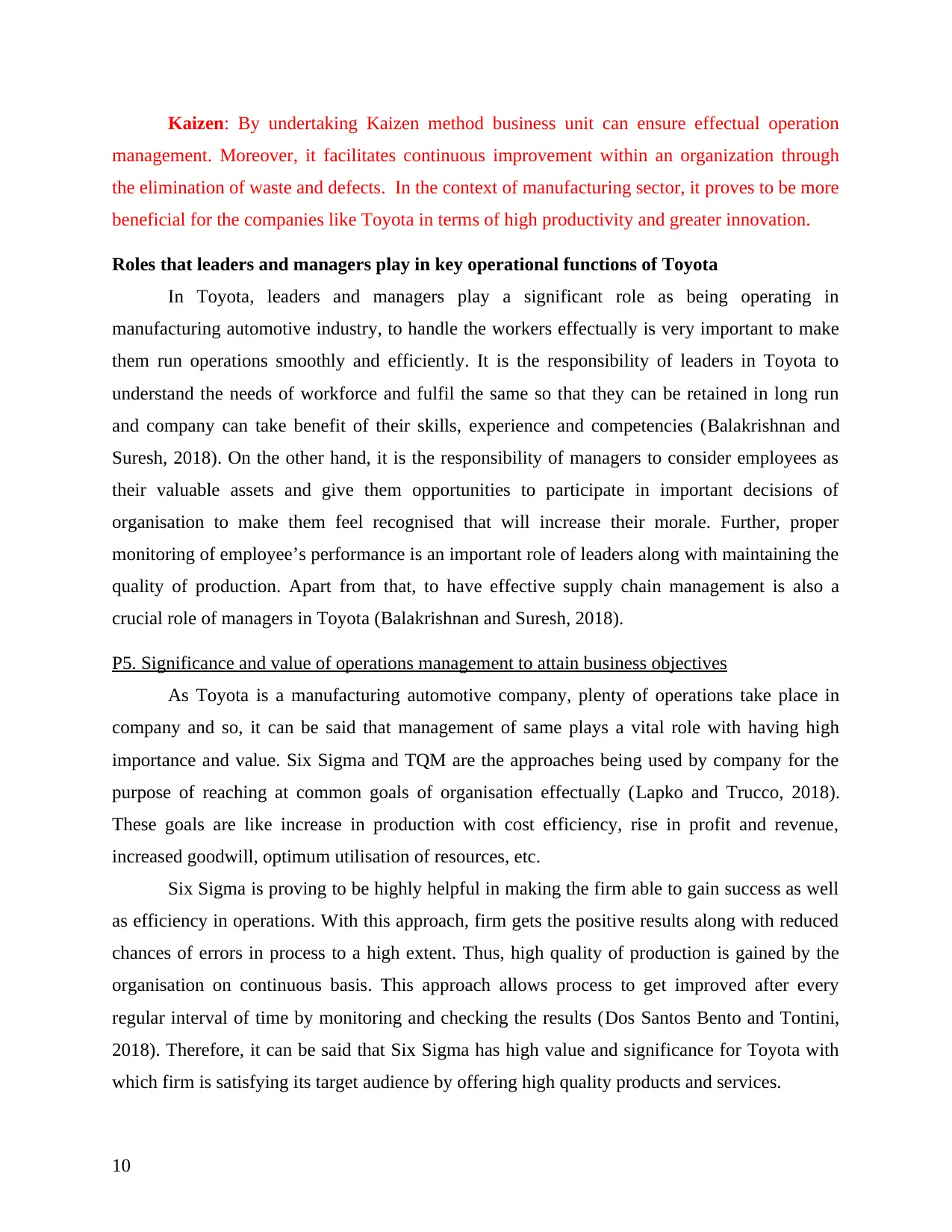
Kaizen: By undertaking Kaizen method business unit can ensure effectual operation
management. Moreover, it facilitates continuous improvement within an organization through
the elimination of waste and defects. In the context of manufacturing sector, it proves to be more
beneficial for the companies like Toyota in terms of high productivity and greater innovation.
Roles that leaders and managers play in key operational functions of Toyota
In Toyota, leaders and managers play a significant role as being operating in
manufacturing automotive industry, to handle the workers effectually is very important to make
them run operations smoothly and efficiently. It is the responsibility of leaders in Toyota to
understand the needs of workforce and fulfil the same so that they can be retained in long run
and company can take benefit of their skills, experience and competencies (Balakrishnan and
Suresh, 2018). On the other hand, it is the responsibility of managers to consider employees as
their valuable assets and give them opportunities to participate in important decisions of
organisation to make them feel recognised that will increase their morale. Further, proper
monitoring of employee’s performance is an important role of leaders along with maintaining the
quality of production. Apart from that, to have effective supply chain management is also a
crucial role of managers in Toyota (Balakrishnan and Suresh, 2018).
P5. Significance and value of operations management to attain business objectives
As Toyota is a manufacturing automotive company, plenty of operations take place in
company and so, it can be said that management of same plays a vital role with having high
importance and value. Six Sigma and TQM are the approaches being used by company for the
purpose of reaching at common goals of organisation effectually (Lapko and Trucco, 2018).
These goals are like increase in production with cost efficiency, rise in profit and revenue,
increased goodwill, optimum utilisation of resources, etc.
Six Sigma is proving to be highly helpful in making the firm able to gain success as well
as efficiency in operations. With this approach, firm gets the positive results along with reduced
chances of errors in process to a high extent. Thus, high quality of production is gained by the
organisation on continuous basis. This approach allows process to get improved after every
regular interval of time by monitoring and checking the results (Dos Santos Bento and Tontini,
2018). Therefore, it can be said that Six Sigma has high value and significance for Toyota with
which firm is satisfying its target audience by offering high quality products and services.
10
management. Moreover, it facilitates continuous improvement within an organization through
the elimination of waste and defects. In the context of manufacturing sector, it proves to be more
beneficial for the companies like Toyota in terms of high productivity and greater innovation.
Roles that leaders and managers play in key operational functions of Toyota
In Toyota, leaders and managers play a significant role as being operating in
manufacturing automotive industry, to handle the workers effectually is very important to make
them run operations smoothly and efficiently. It is the responsibility of leaders in Toyota to
understand the needs of workforce and fulfil the same so that they can be retained in long run
and company can take benefit of their skills, experience and competencies (Balakrishnan and
Suresh, 2018). On the other hand, it is the responsibility of managers to consider employees as
their valuable assets and give them opportunities to participate in important decisions of
organisation to make them feel recognised that will increase their morale. Further, proper
monitoring of employee’s performance is an important role of leaders along with maintaining the
quality of production. Apart from that, to have effective supply chain management is also a
crucial role of managers in Toyota (Balakrishnan and Suresh, 2018).
P5. Significance and value of operations management to attain business objectives
As Toyota is a manufacturing automotive company, plenty of operations take place in
company and so, it can be said that management of same plays a vital role with having high
importance and value. Six Sigma and TQM are the approaches being used by company for the
purpose of reaching at common goals of organisation effectually (Lapko and Trucco, 2018).
These goals are like increase in production with cost efficiency, rise in profit and revenue,
increased goodwill, optimum utilisation of resources, etc.
Six Sigma is proving to be highly helpful in making the firm able to gain success as well
as efficiency in operations. With this approach, firm gets the positive results along with reduced
chances of errors in process to a high extent. Thus, high quality of production is gained by the
organisation on continuous basis. This approach allows process to get improved after every
regular interval of time by monitoring and checking the results (Dos Santos Bento and Tontini,
2018). Therefore, it can be said that Six Sigma has high value and significance for Toyota with
which firm is satisfying its target audience by offering high quality products and services.
10
Paraphrase This Document
Need a fresh take? Get an instant paraphrase of this document with our AI Paraphraser
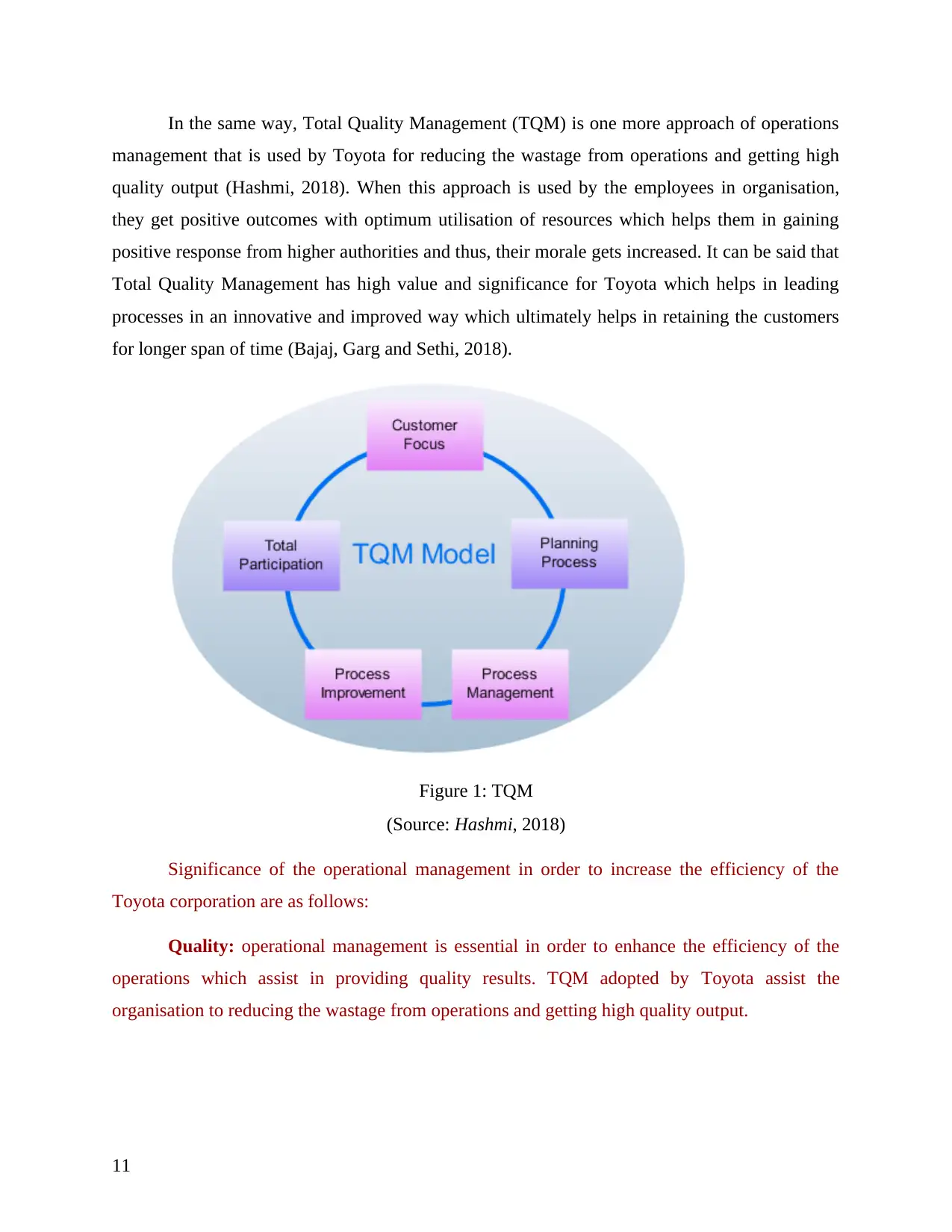
In the same way, Total Quality Management (TQM) is one more approach of operations
management that is used by Toyota for reducing the wastage from operations and getting high
quality output (Hashmi, 2018). When this approach is used by the employees in organisation,
they get positive outcomes with optimum utilisation of resources which helps them in gaining
positive response from higher authorities and thus, their morale gets increased. It can be said that
Total Quality Management has high value and significance for Toyota which helps in leading
processes in an innovative and improved way which ultimately helps in retaining the customers
for longer span of time (Bajaj, Garg and Sethi, 2018).
Figure 1: TQM
(Source: Hashmi, 2018)
Significance of the operational management in order to increase the efficiency of the
Toyota corporation are as follows:
Quality: operational management is essential in order to enhance the efficiency of the
operations which assist in providing quality results. TQM adopted by Toyota assist the
organisation to reducing the wastage from operations and getting high quality output.
11
management that is used by Toyota for reducing the wastage from operations and getting high
quality output (Hashmi, 2018). When this approach is used by the employees in organisation,
they get positive outcomes with optimum utilisation of resources which helps them in gaining
positive response from higher authorities and thus, their morale gets increased. It can be said that
Total Quality Management has high value and significance for Toyota which helps in leading
processes in an innovative and improved way which ultimately helps in retaining the customers
for longer span of time (Bajaj, Garg and Sethi, 2018).
Figure 1: TQM
(Source: Hashmi, 2018)
Significance of the operational management in order to increase the efficiency of the
Toyota corporation are as follows:
Quality: operational management is essential in order to enhance the efficiency of the
operations which assist in providing quality results. TQM adopted by Toyota assist the
organisation to reducing the wastage from operations and getting high quality output.
11
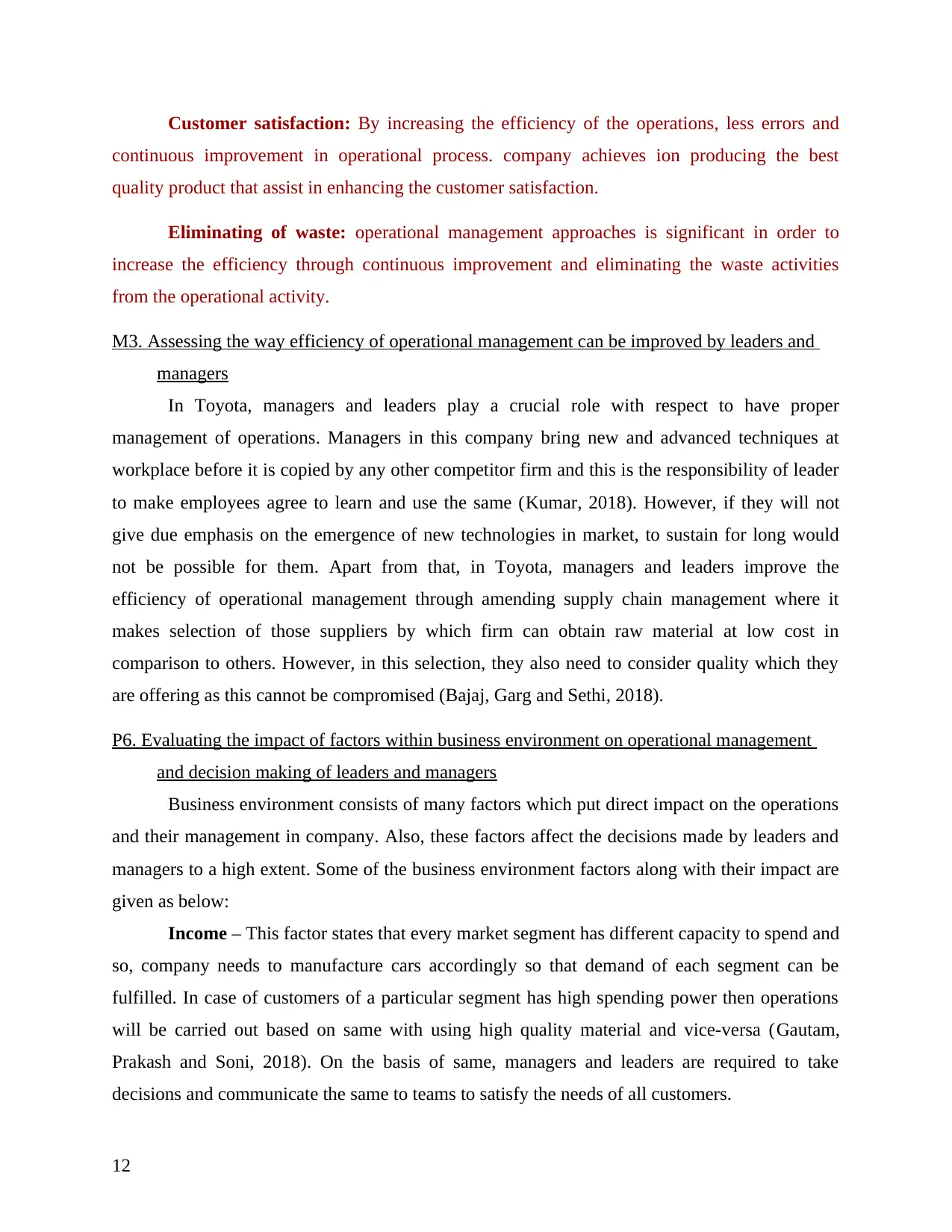
Customer satisfaction: By increasing the efficiency of the operations, less errors and
continuous improvement in operational process. company achieves ion producing the best
quality product that assist in enhancing the customer satisfaction.
Eliminating of waste: operational management approaches is significant in order to
increase the efficiency through continuous improvement and eliminating the waste activities
from the operational activity.
M3. Assessing the way efficiency of operational management can be improved by leaders and
managers
In Toyota, managers and leaders play a crucial role with respect to have proper
management of operations. Managers in this company bring new and advanced techniques at
workplace before it is copied by any other competitor firm and this is the responsibility of leader
to make employees agree to learn and use the same (Kumar, 2018). However, if they will not
give due emphasis on the emergence of new technologies in market, to sustain for long would
not be possible for them. Apart from that, in Toyota, managers and leaders improve the
efficiency of operational management through amending supply chain management where it
makes selection of those suppliers by which firm can obtain raw material at low cost in
comparison to others. However, in this selection, they also need to consider quality which they
are offering as this cannot be compromised (Bajaj, Garg and Sethi, 2018).
P6. Evaluating the impact of factors within business environment on operational management
and decision making of leaders and managers
Business environment consists of many factors which put direct impact on the operations
and their management in company. Also, these factors affect the decisions made by leaders and
managers to a high extent. Some of the business environment factors along with their impact are
given as below:
Income – This factor states that every market segment has different capacity to spend and
so, company needs to manufacture cars accordingly so that demand of each segment can be
fulfilled. In case of customers of a particular segment has high spending power then operations
will be carried out based on same with using high quality material and vice-versa (Gautam,
Prakash and Soni, 2018). On the basis of same, managers and leaders are required to take
decisions and communicate the same to teams to satisfy the needs of all customers.
12
continuous improvement in operational process. company achieves ion producing the best
quality product that assist in enhancing the customer satisfaction.
Eliminating of waste: operational management approaches is significant in order to
increase the efficiency through continuous improvement and eliminating the waste activities
from the operational activity.
M3. Assessing the way efficiency of operational management can be improved by leaders and
managers
In Toyota, managers and leaders play a crucial role with respect to have proper
management of operations. Managers in this company bring new and advanced techniques at
workplace before it is copied by any other competitor firm and this is the responsibility of leader
to make employees agree to learn and use the same (Kumar, 2018). However, if they will not
give due emphasis on the emergence of new technologies in market, to sustain for long would
not be possible for them. Apart from that, in Toyota, managers and leaders improve the
efficiency of operational management through amending supply chain management where it
makes selection of those suppliers by which firm can obtain raw material at low cost in
comparison to others. However, in this selection, they also need to consider quality which they
are offering as this cannot be compromised (Bajaj, Garg and Sethi, 2018).
P6. Evaluating the impact of factors within business environment on operational management
and decision making of leaders and managers
Business environment consists of many factors which put direct impact on the operations
and their management in company. Also, these factors affect the decisions made by leaders and
managers to a high extent. Some of the business environment factors along with their impact are
given as below:
Income – This factor states that every market segment has different capacity to spend and
so, company needs to manufacture cars accordingly so that demand of each segment can be
fulfilled. In case of customers of a particular segment has high spending power then operations
will be carried out based on same with using high quality material and vice-versa (Gautam,
Prakash and Soni, 2018). On the basis of same, managers and leaders are required to take
decisions and communicate the same to teams to satisfy the needs of all customers.
12
⊘ This is a preview!⊘
Do you want full access?
Subscribe today to unlock all pages.

Trusted by 1+ million students worldwide
1 out of 15
Related Documents
Your All-in-One AI-Powered Toolkit for Academic Success.
+13062052269
info@desklib.com
Available 24*7 on WhatsApp / Email
![[object Object]](/_next/static/media/star-bottom.7253800d.svg)
Unlock your academic potential
Copyright © 2020–2025 A2Z Services. All Rights Reserved. Developed and managed by ZUCOL.





